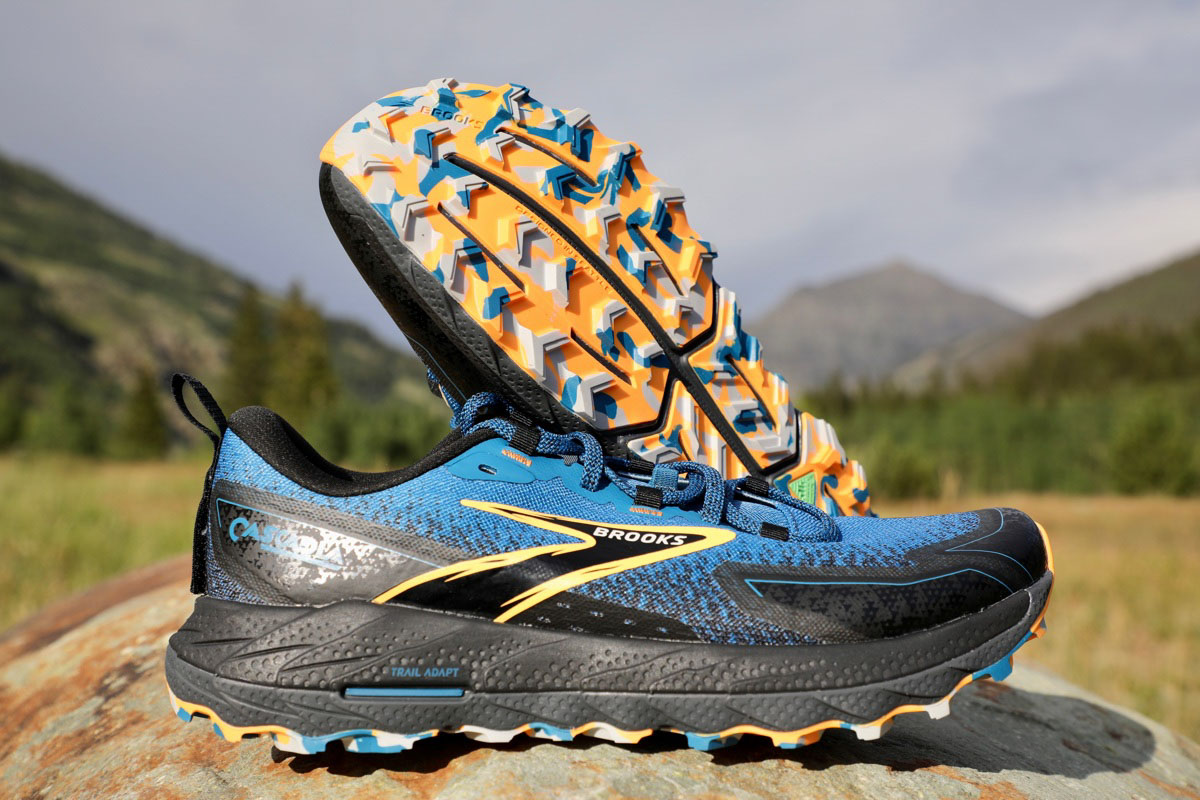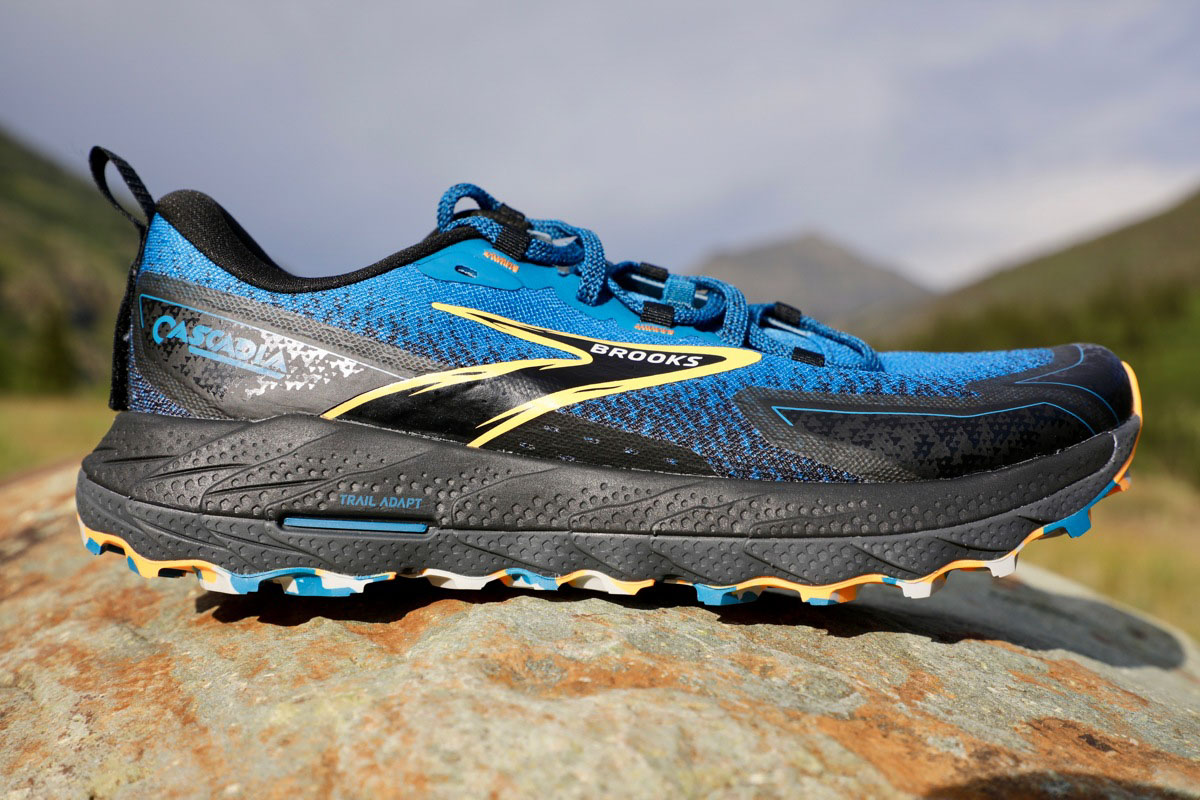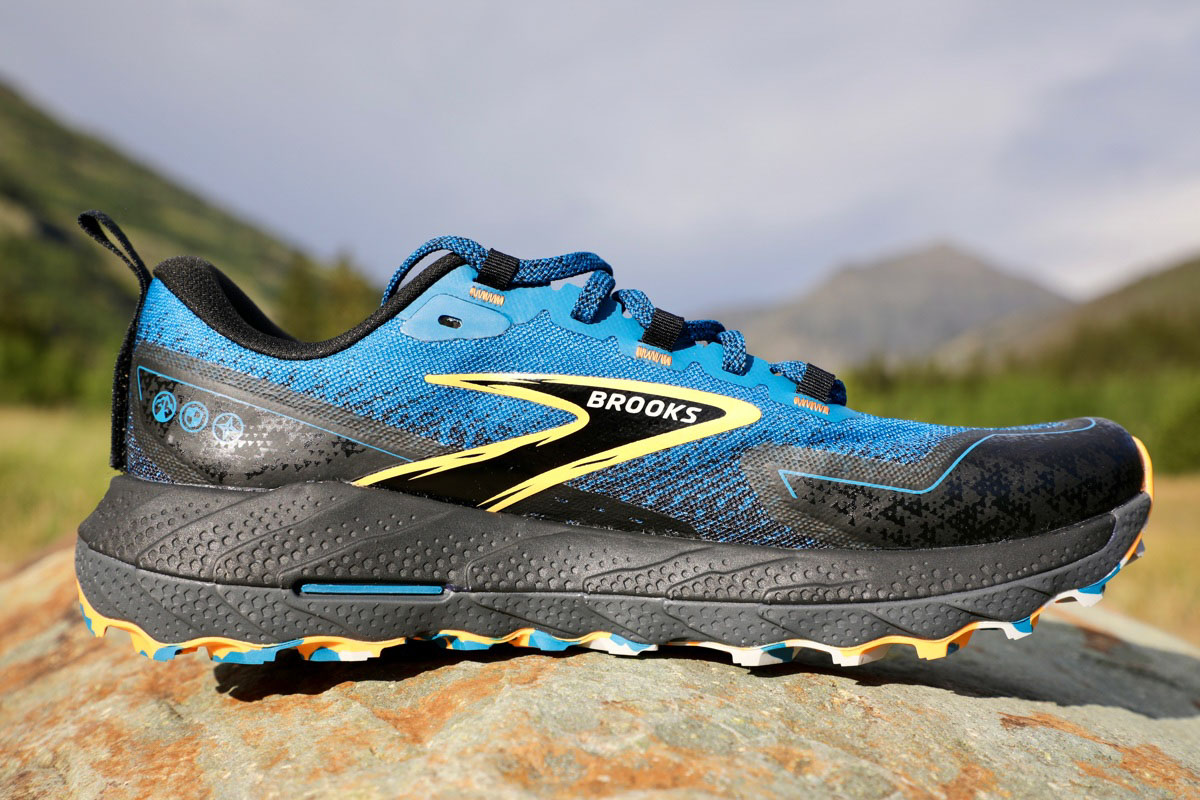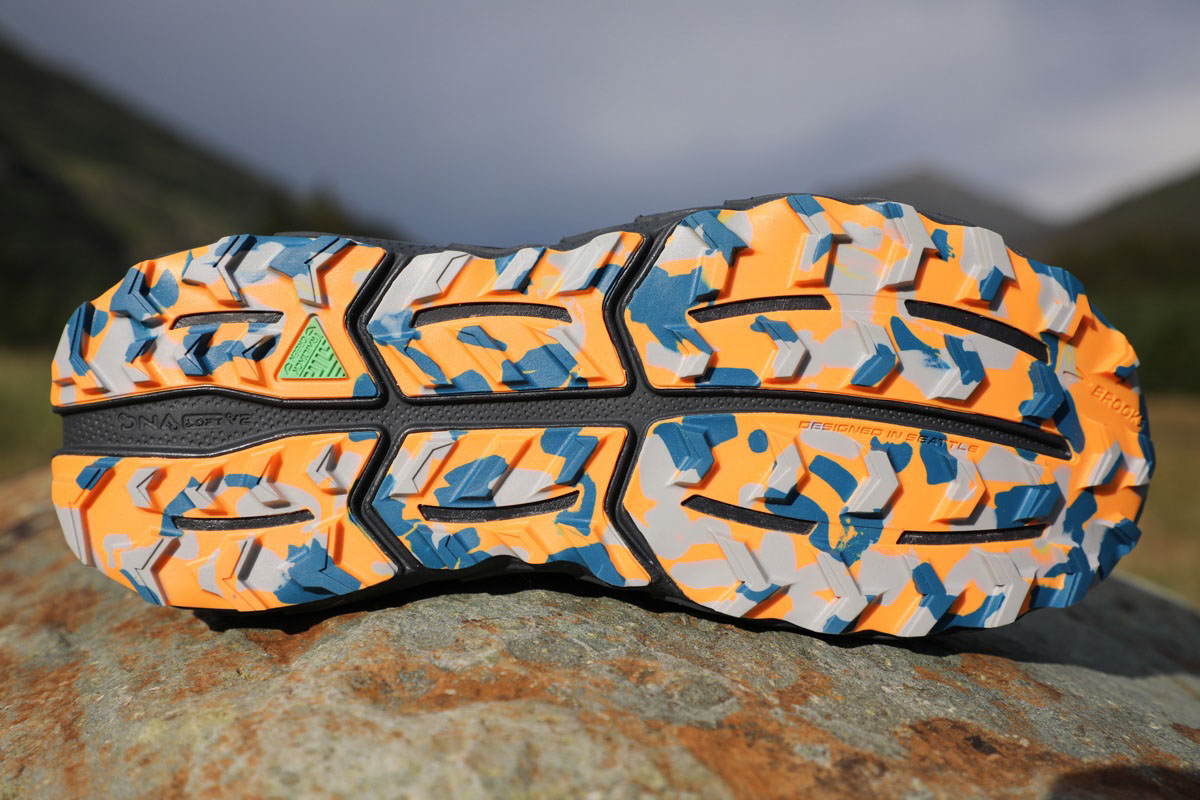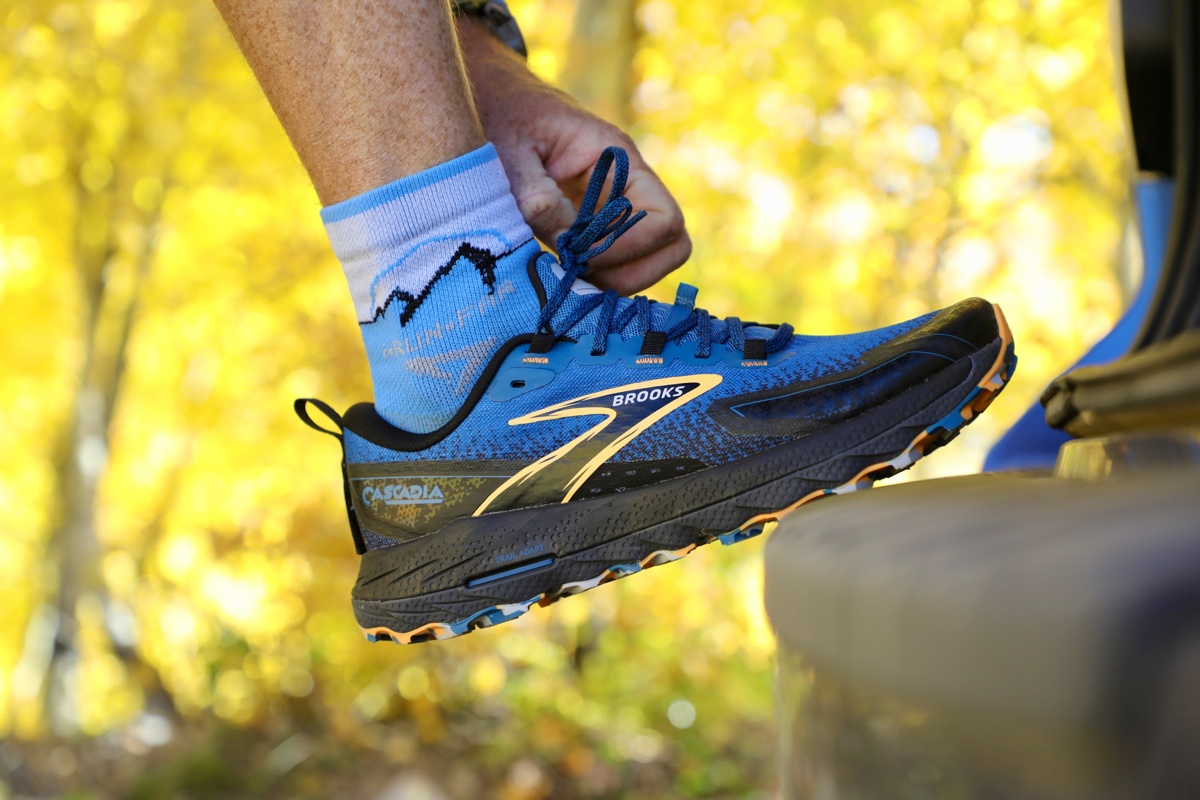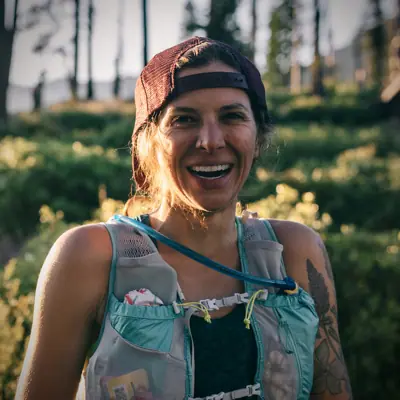The original Brooks Cascadia trail running shoe was a collaboration between Brooks and ultrarunning legend Scott Jurek. The shoe first launched in 2004, and Jurek won the Western States 100 while wearing them that same year. At this year’s States, I got my feet into a pair of the shoe’s newest iteration, the Brooks Cascadia 18 ($140), while hanging out at the Foresthill aid station.
After wiggling my toes in them and trotting a few steps, I decided the fit felt pretty good and told the folks at the Brooks tent that I’d wear them to pace my friend later that night through the final 22 miles of the race. In the wee hours of the following morning, my runner and I chatted briefly with Jurek at the Quarry Road aid station at mile 91, where he was volunteering, though we were all too focused on the race to strike up a detailed conversation about the shoe’s 20-year history.
A notable update with this edition is a new mesh upper with overlays for improved durability. The Brooks Cascadia 18 has an actual weight of 10.9 ounces (308 grams) in a U.S. men’s size 9, and like its predecessors, it has an 8-millimeter drop with stack heights of 33 and 25 millimeters at the heel and toe, respectively.
Designed for mountain trails and all distances, the Cascadia line continues to be one of our top picks in our Best Trail Running Shoes guide.
Shop the Women's Brooks Cascadia 18Shop the Men's Brooks Cascadia 18
Brooks Cascadia 18 Upper
The Brooks Cascadia 18 has a new single-layer mesh upper with overlays in high-wear areas for increased durability. The overlays are at the front of the shoe, around the outside of the toebox, and made of a thin material that bends with the shoe. The upper itself feels smooth and abrasion-resistant, and the new overlays seem like they’ll be resistant to cracking or splitting. After 100 miles on trails in California and Oregon, there’s no sign of wear on the outside of the shoe’s upper. However, some wear spots are forming around the top of the heel collar and just inside the back of the shoe where the Achilles tendon comes in contact with the shoe lining.
The sturdy laces and lightly cushioned gusseted tongue appear similar to the previous version. The laces stay securely tied, even when wet. I tuck them into the elastic lace keeper on the top to prevent them from getting snagged on the trail.
Finally, as with other recent Cascadia models, these shoes have a small webbing loop on the back to help you tug the shoe onto your foot. They also have a hook-and-loop tab on the back for attaching a gaiter and are compatible with any running gaiters that attach with a hook-and-loop system or via a stirrup strap.
The Cascadia 18 upper felt light and breathable, even while running in 90-degree Fahrenheit temperatures near Auburn, California, and in Bend, Oregon. When I splashed through creeks, these shoes drained and dried quickly enough that I never gave them a second thought. My foot felt securely locked in, even on steep trails that were mostly moon dust and loose rock, yet my toes had enough room in the front to grip and flex.

iRunFar founding editor Bryon Powell running in the Brooks Cascadia 18 in Colorado’s San Juan Mountains. Photo: iRunFar/Meghan Hicks
Brooks Cascadia 18 Midsole
The Brooks Cascadia 18 features the brand’s DNA Loft v2 midsole foam, a new addition to the line a few years ago with the Brooks Cascadia 16. The midsole has a moderate cushion level, with 20 millimeters of foam under the heel and 12 millimeters under the forefoot. The 8-millimeter drop is mid-range and will work well for almost any runner. The DNA Loft v2 foam is soft and comfortable out of the box, requiring minimal break-in time. Even after putting 22 miles on these shoes on my first run, my feet felt fresh, and I experienced no hot spots.
Although this shoe’s midsole foam lacks the bouncy responsiveness that we see in other trail shoes, like the Nike Zegama 2 with its ZoomX foam or the Hoka Mafate Speed 4 with its ProFly+ foam, the Cascadia also doesn’t feel mushy or flat. During a workout that involved short tempos capped off with one minute of hard effort on rolling singletrack, the shoe handled the variety of turnover just fine. I never felt like the shoes were slapping the ground or holding me back. After 100 miles of testing, the midsole still feels the same as it did on day one with no sign of breakdown. Finally, it’s worth noting that while the Cascadia may not have a super fancy midsole foam, it has a much more approachable price tag than many of its competitors.
Thanks to a forked rock plate layered between two pieces of midsole foam, the shoe is impressively stable and protective. While traversing technical trails layered with rocks and exposed roots, descending steep trails of loose scree and billowing dust, and bombing down a gravel road during a workout, my feet never felt achy or bruised after hammering over rough terrain. My heels and ankles also never wobbled while bounding from rock to rock.
Brooks Cascadia 18 Outsole
The Brooks Cascadia 18 outsole remains unchanged from the Brooks Cascadia 17, which had received an update from the previous version. The brand’s TrailTack Green rubber outsole is made of 25% recycled materials and has 4.5-millimeter lugs in a goat-hoof-inspired lug pattern. During testing, the outsole gripped well on loose dirt, wet rocks and roots, and smooth, rounded rocks. Due to the dry summer season, I haven’t had a chance to test them on icy trails, packed snow, or thick mud.
Although primarily designed for trail, this shoe also performs well on pavement and hard-packed gravel or dirt. Over the past several weeks, I spent many mornings running the flat asphalt bike path near my house to Pilot Butte State Park in Oregon and then hammering several hundred feet up the dirt trail to the summit. The Cascadia 18 never felt clunky or sticky on pavement. In fact, I never even thought about the transitions between roads and trails while running in these shoes.
Brooks Cascadia 18 Overall Impressions
Overall, the Brooks Cascadia 18 is an approachable shoe that can appeal to a wide range of runners. Its moderate cushion and heel-to-toe drop, traditional fit and profile, and on- and off-road-friendly outsole give it a versatility you don’t get with more specialized running shoes. Although it doesn’t have a super tech-y outsole compound or cutting-edge midsole foam, it’s a time-tested shoe that has remained well-loved for decades, for good reason. And at a time when running shoes are getting more and more expensive, it offers a quality option at a price that’s relatively easy on the wallet.
From a short lap around the neighborhood to a 100-mile race, and from easy-day plodding to speed workouts, the Brooks Cascadia 18 is a workhorse that can handle just about anything. It’s lightweight and breathable, yet sturdy and reliable. Despite the minor wear showing in the shoe’s lining material, I imagine that I’ll get 300 or more miles out of it.
The iRunFar team loves the time-tested and trusted Cascadia line, so the Brooks Cascadia continues to be a top pick in our Best Trail Running Shoes guide.
Shop the Women's Brooks Cascadia 18Shop the Men's Brooks Cascadia 18
Call for Comments
- Are you a Brooks Cascadia fan? Which version has been your favorite, and how does this newest version compare?
- Do you prefer one trail running shoe that can do most things well or a quiver of specialist shoes? Which shoes do you keep in your rotation?
Our Favorite Trail Running Shoes
Check out our Best Trail Running Shoes article to learn about our current favorite trail running shoes!
